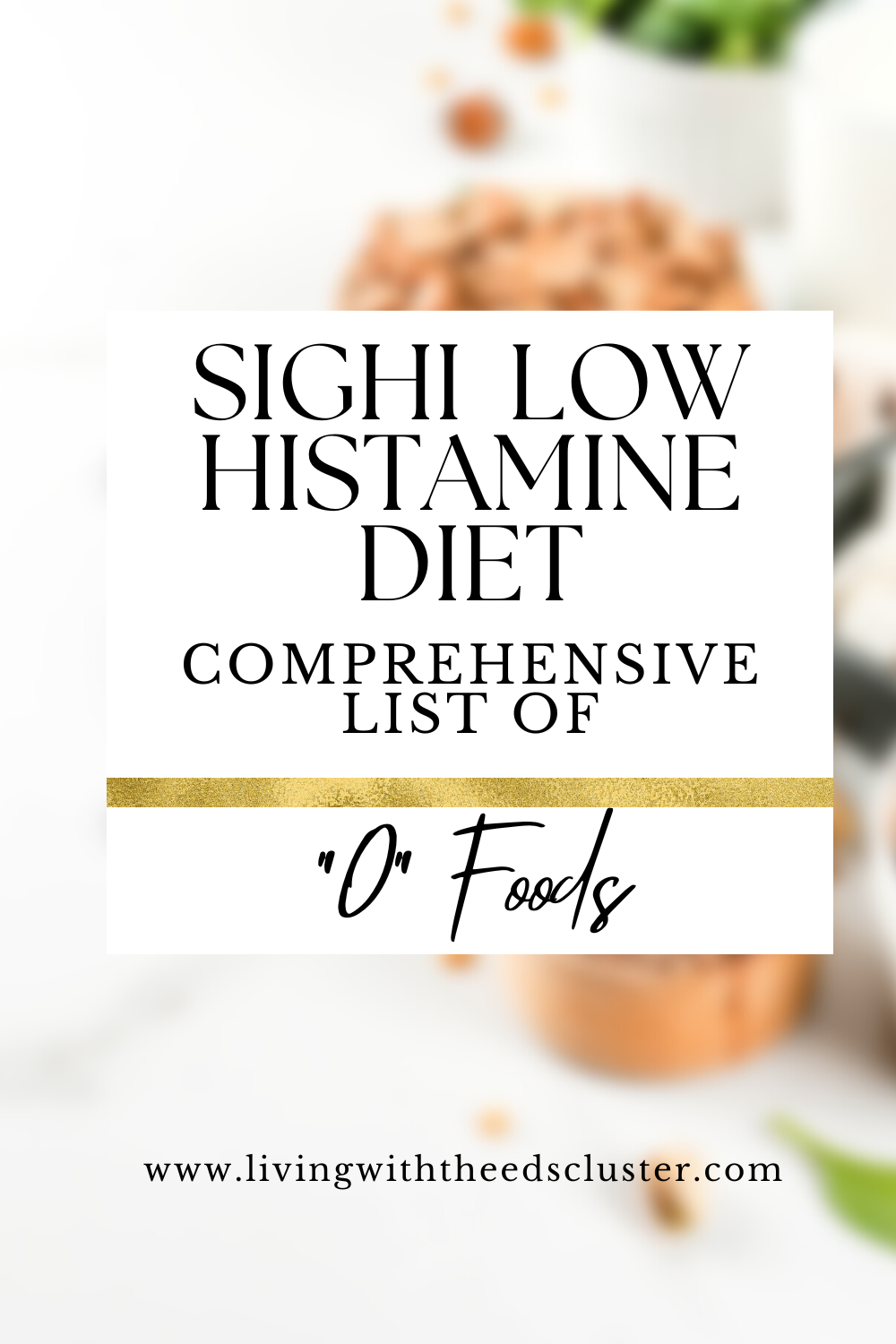As mentioned in my prior post about the low histamine diet, histamine is a natural compound that is produced in the body during allergic reactions and during food digestion. It can cause inflammation, allergies, and other health problems. Therefore, it is important to reduce histamine intake through a low histamine diet. This diet eliminates foods that are high in histamine and replaces them with more nutritious options.
The SIGHI food list is a comprehensive guide to foods low in histamine content. It includes fruits, vegetables, meats and fish, dairy products, grains, and legumes. The list gives a grade of 0-3 (well-tolerated to very poorly tolerated/severe symptoms). I try to stick with 0’s and 1’s, and only eat 2’s sparingly. I try to never eat 3’s. This document from the Swiss Interest Group Histamine Intolerance (SIGHI) is the best resource I have found for low histamine food. I highly recommend printing it out and taking it with you grocery shopping or to restaurants.
In this post, I detail out all the 0’s so it’s a little easier to know what you can eat, as opposed to what you shouldn’t eat. I will be adding a second post on the 1’s we can eat as well – I had to split 0’s and 1’s because the list was getting too long 🙂
List of 0 foods:
- Fruits
- Acerola, Acerola Powder, Barbados Cherry, West Indian Cherry, Wild Crepe Myrtle
- Apple
- Apricot
- Blackberry
- Blackcurrants
- Blueberry
- Carambola, Starfruit
- Cherry
- Cocoa Butter
- Coconut (includes shavings and milk)
- Cowberry
- Cranberry
- Dates
- Dragon Fruit
- Goji berry, Chinese wolfberry, Chinese boxthorn, Himalayan goji, Tibetan goji
- Gooseberry
- Grapes
- Jostaberry
- Kaki
- Lingonberry
- Lychee
- Melons (expect watermelon)
- Morello cherries
- Nectarine
- Peach
- Persimmon
- Pitaya
- Pomegranate
- Quince
- Raisins
- Redcurrants
- Sallow thorn
- Sharon Fruit
- Sour cherries
- Vegetables
- Artichoke
- Asparagus
- Beetroot
- Bell pepper, sweet
- Bok choi
- Broccoli
- Cabbage, green or white
- Carrot
- Cauliflower
- Celery
- Celery cabbage
- Chicory
- Corn salad, lamb’s lettuce
- Courgette
- Cucumber
- Endive
- Fennel
- Gourds
- Lettuce, iceberg, head and leaf lettuces
- Marrow
- Napa cabbage
- Pak choi
- Pumpkins
- Radish (red and white)
- Red cabbage
- Squashes
- White onion
- Zucchini
- Eggs
- Egg Yolk (not including the egg whites)
- Quail Eggs
- Dairy
- Butter: Sweet cream butter (Sweet cream butter is the normal butter, not fermented with bacteria.)
- Butterkaese
- cream cheeses (means: very young cheeses), plain, without additives (Tolerated if unfermented. Always check for additives. Mostly contains intolerated thickeners or stabilizers)
- Cream, sweet, without additives
- Curd cheese
- Ewe’s milk, sheep’s milk
- Farmer’s cheese (a type of fresh cheese)
- Geheimratskaese, Geheimrats cheese
- Goat’s milk, goat milk
- Gouda cheese (young) (Eat small quantities only.)
- Mascarpone cheese
- Milk, pasteurized (Milk may be incompatible, as long as the bowel is still irritated.)
- Milk, UHT (UHT = ultra-high temperature processing, ultra-heat treatment)
- Mozzarella cheese
- Quark
- Raw milk (Perishable due to higher bacterial count. Use only fresh.)
- Ricotta cheese
- Sheep’s milk, sheep milk
- Whey
- Meat
- Beef (fresh)
- Chicken
- Duck
- Minced meat (if eaten immediately after its production) (Strongly depends on the freshness)
- Ostrich
- Poultry meat
- Quail
- Tongue (veal, beef) (Check for intolerated ingredients if processed ready to eat. No smoked products.)
- Turkey
- Veal (fresh)
- Fish
- Fish (freshly caught or frozen) (Extremely dependent on freshness and species)
- trout (freshwater): brown trout, brook trout, rainbow trout (Perishable. Rapid histamine formation.)
- Miscellaneous
- Lard
- Starches
- Amaranth, Amaranthus (May cause diarrhea in some cases. This entry refers to the pseudo grain called amaranth, (plant genus Amaranthus). Not to be confused with the azo dye amaranth (an artificial food coloring).)
- Chestnut, sweet chestnut
- Cornflakes (if no additives such as malt or folic acid)
- Hemp seeds (Cannabis sativa) (The legal non-psychoactive subspecies)
- KAMUT®, Khorasan wheat (Prefer old varieties (e.g. KAMUT®). Modern ATI-varieties modified by cultivation are often not well tolerated.)
- Khorasan wheat or Oriental wheat (Triticum turgidum ssp.turanicum), KAMUT® (Prefer old varieties (e.g. KAMUT®). Modern ATI-varieties modified by cultivation are often not well tolerated)
- Maltodextrin
- Millet
- Oats (Some varieties may sometimes be intolerated (flatulence).)
- Pearl sago
- Potato with peel (Dark place! Green points are poisonous! Possibly incompatible for those with salicylate intolerance)
- Potato, new, with peel (Dark place! Green points are poisonous! Possibly incompatible for those with salicylate intolerance)
- Potato, peeled (Dark place! Green points are poisonous!)
- Quinoa (Possibly not always well tolerated)
- Rice (After cooking, store in the fridge up to 12-24 hours max.)
- Rice biscuits, rice cakes (Slightly worse tolerated than freshly cooked rice)
- Rice crispies (Be careful with malt, folic acid)
- Rice noodles (Slightly worse tolerated than freshly cooked rice)
- Sago
- Spelt (Prefer old varieties. Modern ATI-varieties modified by cultivation are often not well tolerated.)
- Sweet corn, maize kernels: corn on the cob, fresh / pasteurised (Hard to digest.)
- Sweet corn, maize kernels: dried (maize meal, maize flour)
- Sweet corn, maize kernels: out of the tin (Hard to digest. Possibly incompatible after long-term storage or in large quantities)
- Sweet potato
- Wild rice
- Yam
- Nuts
- Brazil nut
- Chufa sedge (Cyperus esculentus) (Must not be roasted.)
- Earth almond
- Macadamia
- Nut grass
- Pistachio
- Tiger nut sedge
- Yellow nutsedge
- Fats and Oils
- Black caraway oil (Nigella sativa) (antiallergic)
- canola oil
- coconut fat, coconut oil, copra oil
- fennel flower oil (Nigella sativa)
- margarine (check for intolerated additives)
- Nigella sativa oil
- nutmeg flower oil (Nigella sativa)
- olive oil
- palm kernel oil
- palm oil, dendê oil
- pumpkin seed oil
- rape seed oil
- Roman coriander oil (Nigella sativa)
- safflower oil
- Herbs
- Basil
- Mint
- Oregano
- Parsley
- Rosemary
- Sage
- Savory
- Seeds
- Chia
- Psyllium seed husks
- Pumpkin Seeds
- Sweetners
- Agave nectar, agave syrup
- Birch sugar, xylitol, xylite, E967
- Caramel (browned sugar)
- Dextrose (Glucose syrup may contain a lot of fructose, pure glucose is free from fructose.)
- E420, sorbitol, glucitol
- E967, xylitol, xylite, birch sugar
- Fructose (fruit sugar) (Too much will cause indigestion.)
- Glucose (Glucose syrup may contain a lot of fructose, pure glucose is free from fructose.)
- Honey (To be debated. Uneven. Naturally contains benzoic acid.)
- Inverted sugar syrup, invert sugar syrup
- Lactose (milk sugar)
- Maltose, malt sugar (pure)
- Maple syrup
- Sorbitol, glucitol, E420
- Stevia (stevia leaves, liquid, powder)
- Sucrose (Nevertheless, should be used sparingly, not as a main nutrient.)
- Sugar (beet sugar, cane sugar) (Nevertheless, should be used sparingly, not as a main nutrient.)
- Xylitol, xylite, birch sugar, E967
- Spices and Seasonings
- Black caraway
- Caraway
- Cardamom
- Cilantro
- Cinnamon
- Cloves
- Coriander
- Distilled white vinegar
- Fennel Flower
- Juniper berries
- Meridian fennel
- Nigella sativa seed
- Nutmeg flower
- Paprika, sweet
- Persian cumin
- Roman coriander
- Spirit vinegar
- Thyme
- Turmeric
- Vinegar (white and spirit are the only 0’s)
- Beverages
- Chamomile tea
- Mineral water, still
- Tap water
- Lime blossom team
- Peppermint tea
- Rooibos tea
- Sage tea
- Verbena herbal tea
- Cranberry nectar
- Elderflower Cordial


One response to “SIGHI Low Histamine 0 Foods Comprehensive List”
[…] recommend printing it out and taking it with you grocery shopping or to restaurants. I have another post that details all the 0’s and 1’s, so it’s a little easier to know what you can […]